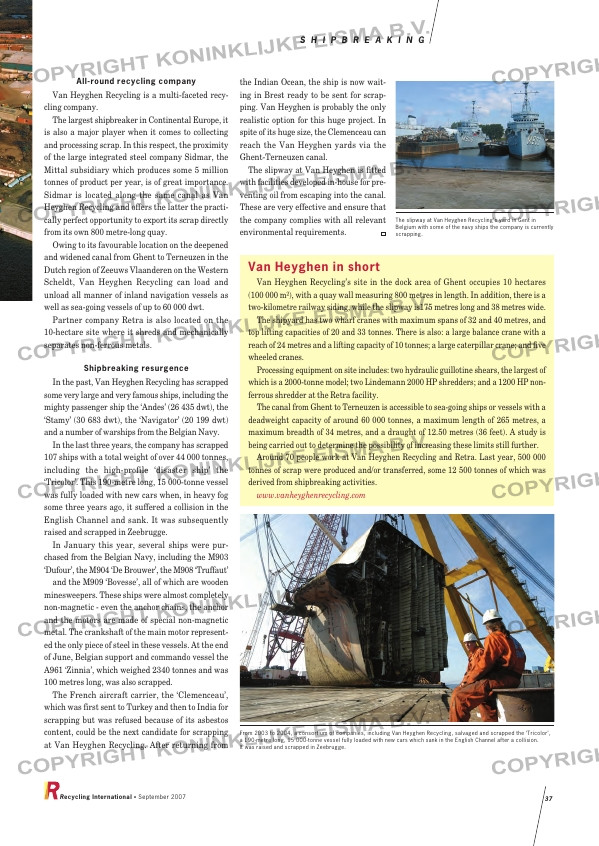Page 37 from: September 2007

All-round recycling company
Van Heyghen Recycling is a multi-faceted recy-
cling company.
The largest shipbreaker in Continental Europe, it
is also a major player when it comes to collecting
and processing scrap. In this respect, the proximity
of the large integrated steel company Sidmar, the
Mittal subsidiary which produces some 5 million
tonnes of product per year, is of great importance.
Sidmar is located along the same canal as Van
Heyghen Recycling and offers the latter the practi-
cally perfect opportunity to export its scrap directly
from its own 800 metre-long quay.
Owing to its favourable location on the deepened
and widened canal from Ghent to Terneuzen in the
Dutch region of Zeeuws Vlaanderen on the Western
Scheldt, Van Heyghen Recycling can load and
unload all manner of inland navigation vessels as
well as sea-going vessels of up to 60 000 dwt.
Partner company Retra is also located on the
10-hectare site where it shreds and mechanically
separates non-ferrous metals.
Shipbreaking resurgence
In the past, Van Heyghen Recycling has scrapped
some very large and very famous ships, including the
mighty passenger ship the ‘Andes’ (26 435 dwt), the
‘Stamy’ (30 683 dwt), the ‘Navigator’ (20 199 dwt)
and a number of warships from the Belgian Navy.
In the last three years, the company has scrapped
107 ships with a total weight of over 44 000 tonnes,
including the high-profile ‘disaster ship’ the
‘Tricolor’. This 190-metre long, 15 000-tonne vessel
was fully loaded with new cars when, in heavy fog
some three years ago, it suffered a collision in the
English Channel and sank. It was subsequently
raised and scrapped in Zeebrugge.
In January this year, several ships were pur-
chased from the Belgian Navy, including the M903
‘Dufour’, the M904 ‘De Brouwer’, the M908 ‘Truffaut’
and the M909 ‘Bovesse’, all of which are wooden
minesweepers. These ships were almost completely
non-magnetic – even the anchor chains, the anchor
and the motors are made of special non-magnetic
metal. The crankshaft of the main motor represent-
ed the only piece of steel in these vessels. At the end
of June, Belgian support and commando vessel the
A961 ‘Zinnia’, which weighed 2340 tonnes and was
100 metres long, was also scrapped.
The French aircraft carrier, the ‘Clemenceau’,
which was first sent to Turkey and then to India for
scrapping but was refused because of its asbestos
content, could be the next candidate for scrapping
at Van Heyghen Recycling. After returning from
the Indian Ocean, the ship is now wait-
ing in Brest ready to be sent for scrap-
ping. Van Heyghen is probably the only
realistic option for this huge project. In
spite of its huge size, the Clemenceau can
reach the Van Heyghen yards via the
Ghent-Terneuzen canal.
The slipway at Van Heyghen is fitted
with facilities developed in-house for pre-
venting oil from escaping into the canal.
These are very effective and ensure that
the company complies with all relevant
environmental requirements.
S H I P B R E A K I N G
Recycling International • September 2007 37
Van Heyghen in short
Van Heyghen Recycling’s site in the dock area of Ghent occupies 10 hectares
(100 000 m²), with a quay wall measuring 800 metres in length. In addition, there is a
two-kilometre railway siding, while the slipway is175 metres long and 38 metres wide.
The shipyard has two wharf cranes with maximum spans of 32 and 40 metres, and
top lifting capacities of 20 and 33 tonnes. There is also: a large balance crane with a
reach of 24 metres and a lifting capacity of 10 tonnes; a large caterpillar crane; and five
wheeled cranes.
Processing equipment on site includes: two hydraulic guillotine shears, the largest of
which is a 2000-tonne model; two Lindemann 2000 HP shredders; and a 1200 HP non-
ferrous shredder at the Retra facility.
The canal from Ghent to Terneuzen is accessible to sea-going ships or vessels with a
deadweight capacity of around 60 000 tonnes, a maximum length of 265 metres, a
maximum breadth of 34 metres, and a draught of 12.50 metres (36 feet). A study is
being carried out to determine the possibility of increasing these limits still further.
Around 70 people work at Van Heyghen Recycling and Retra. Last year, 500 000
tonnes of scrap were produced and/or transferred, some 12 500 tonnes of which was
derived from shipbreaking activities.
www.vanheyghenrecycling.com
From 2003 to 2004, a consortium of companies, including Van Heyghen Recycling, salvaged and scrapped the ‘Tricolor’,
a 190-metre long, 15 000-tonne vessel fully loaded with new cars which sank in the English Channel after a collision.
It was raised and scrapped in Zeebrugge.
The slipway at Van Heyghen Recycling’s yard in Gent in
Belgium with some of the navy ships the company is currently
scrapping.
RI_014 Shipbreaking:Opmaak 1 05-09-2007 12:50 Pagina 37



